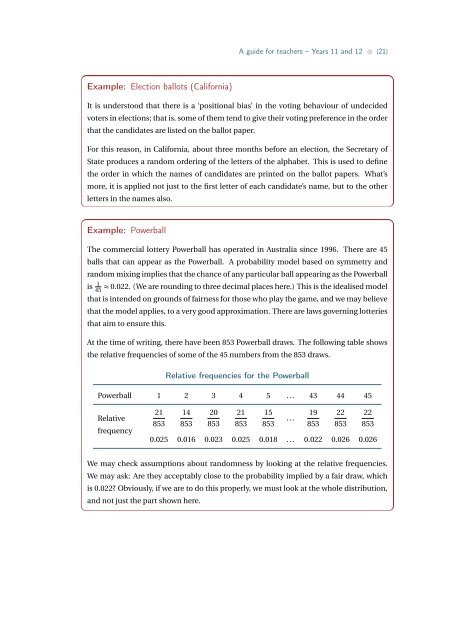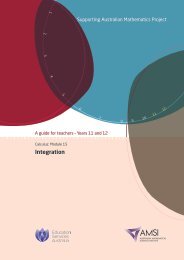Probability - the Australian Mathematical Sciences Institute
Probability - the Australian Mathematical Sciences Institute
Probability - the Australian Mathematical Sciences Institute
- No tags were found...
Create successful ePaper yourself
Turn your PDF publications into a flip-book with our unique Google optimized e-Paper software.
A guide for teachers – Years 11 and 12 • {21}Example: Election ballots (California)It is understood that <strong>the</strong>re is a ‘positional bias’ in <strong>the</strong> voting behaviour of undecidedvoters in elections; that is, some of <strong>the</strong>m tend to give <strong>the</strong>ir voting preference in <strong>the</strong> orderthat <strong>the</strong> candidates are listed on <strong>the</strong> ballot paper.For this reason, in California, about three months before an election, <strong>the</strong> Secretary ofState produces a random ordering of <strong>the</strong> letters of <strong>the</strong> alphabet. This is used to define<strong>the</strong> order in which <strong>the</strong> names of candidates are printed on <strong>the</strong> ballot papers. What’smore, it is applied not just to <strong>the</strong> first letter of each candidate’s name, but to <strong>the</strong> o<strong>the</strong>rletters in <strong>the</strong> names also.Example: PowerballThe commercial lottery Powerball has operated in Australia since 1996. There are 45balls that can appear as <strong>the</strong> Powerball. A probability model based on symmetry andrandom mixing implies that <strong>the</strong> chance of any particular ball appearing as <strong>the</strong> Powerballis 145≈ 0.022. (We are rounding to three decimal places here.) This is <strong>the</strong> idealised modelthat is intended on grounds of fairness for those who play <strong>the</strong> game, and we may believethat <strong>the</strong> model applies, to a very good approximation. There are laws governing lotteriesthat aim to ensure this.At <strong>the</strong> time of writing, <strong>the</strong>re have been 853 Powerball draws. The following table shows<strong>the</strong> relative frequencies of some of <strong>the</strong> 45 numbers from <strong>the</strong> 853 draws.Relative frequencies for <strong>the</strong> PowerballPowerball 1 2 3 4 5 ... 43 44 45Relativefrequency21 14 20 21 1519 22 22...853 853 853 853 853 853 853 8530.025 0.016 0.023 0.025 0.018 ... 0.022 0.026 0.026We may check assumptions about randomness by looking at <strong>the</strong> relative frequencies.We may ask: Are <strong>the</strong>y acceptably close to <strong>the</strong> probability implied by a fair draw, whichis 0.022? Obviously, if we are to do this properly, we must look at <strong>the</strong> whole distribution,and not just <strong>the</strong> part shown here.
















